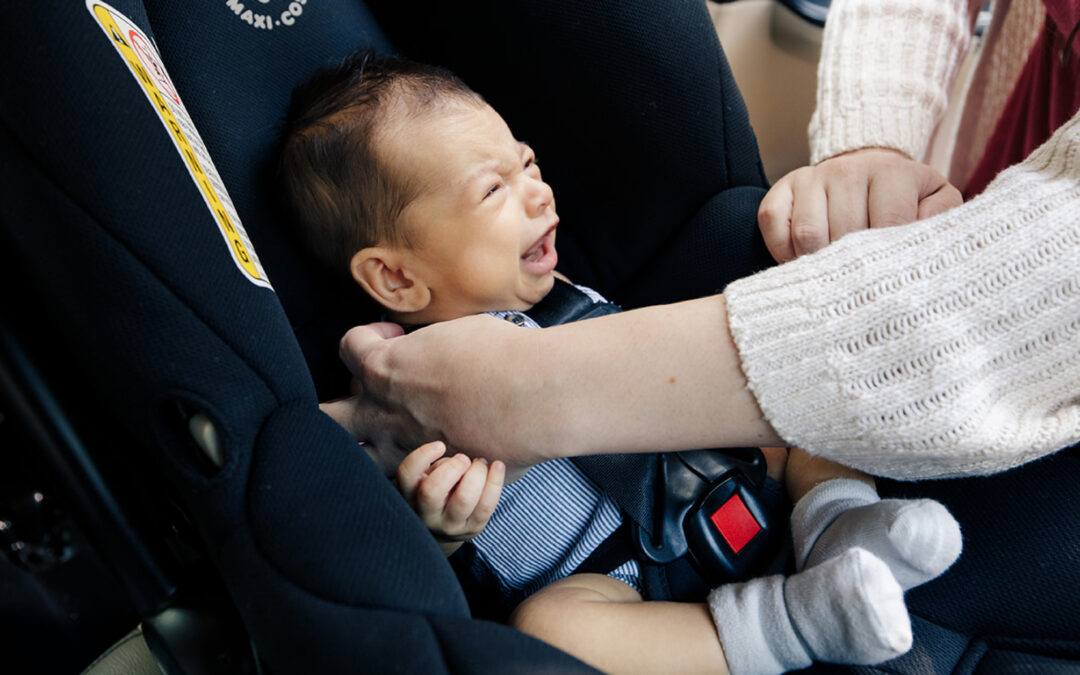If you’ve been following Safe in the Seat for a while, you’re probably a car seat science pro — you know the why and how when it comes to proper car seat installation and harnessing. But, at the end of the day, does that matter if your kiddo doesn’t even like the car seat? (Yes, but it makes a hard thing that much harder.) Trust me, I had a car seat screamer too. Plus, when your little is screaming every time you’re in the car, you can get distracted; and distracted driving took the lives of over 3,000 drivers in the U.S. in 2017.
So what’s a parent to do if driving is the car is something some babies hate? Everyone from your pediatrician to your mother-in-law probably has well-intentioned “advice” to help you navigate this situation, ranging from silly (Baby Shark on repeat!) to absurd (only drive during naptime? With blaring white noise? How?!) to downright dangerous (turn your one-year-old forward facing? no way!). Let’s look at some common underlying culprits when it comes to car seat screamers and lots of suggestions that can help you get to the root of your problem.
Why Kids Hate the Car Seat
Here are some common reasons kids hate riding in their car seat — and some real solutions that might just make everyone’s car ride experience more comfortable!
Improper fit
That’s right, proper harness fit is critical not only for safety but for comfort! Even if you’re well-versed in car seat basics and making sure your seat is installed correctly, there are common mistakes you might still be making. And you’re not alone! Maybe your not-so-little little one has grown since the last round of car seat adjustments you made. Triple-check that your harness height, crotch buckle setting, insert use, and harness strap tightness are all good to go each time you’re putting your baby in the seat. If you need help making sure you’ve achieved perfection, schedule a virtual consult with us or find a certified car seat safety technician near you.
Keep your baby safe with The Infant Course: an online course designed to take you from confused to confident during your baby’s first year of car seat safety. Protect your child with The Convertible Car Seat Course: the practical, step-by-step course to take you from confused to confident in the convertible car seat stage.
Perfected your fit and still have a car seat complainer? Here are a few other potential reasons:
Separation anxiety.
Being in a car seat “alone” (as opposed to mama or papa’s arms) is no fun for older babies and growing toddlers. It’s boring and lonely in that backseat! If this might be the root of your kiddo’s discontentment, try having mom or dad ride in the backseat with baby when another adult is available to drive. (Note: If this becomes a habit, it can be hard to break, sending you right back to the scream zone when you’re alone with your child and nobody’s available to entertain them from the backseat. With that in mind, consider saving this trick for those times you really need it, like family outings with longer car trips!) You can also help your child feel safe and connected by setting up a mirror that gives your toddler a rear-view mirror view of mama — just make sure to secure that mirror carefully so it doesn’t become a dangerous projectile! — or giving your kiddo a special stuffed animal to keep them company on the road.
Too hot or too cold.
Even if you’ve ruled out harness fit issues, there might be other factors causing physical discomfort in the car seat. Temperature is a big one! If you’re lucky enough to have ceiling vents, point one at your child; if you’re not, consider grabbing a Noggle so your little one can enjoy better ventilation in the backseat. Stick to lightweight clothing in the car and consider these other tips to help your backseat passengers stay cool. And keep a blanket on hand in case your toddlers have the opposite problem!
Baby got gas!
Tummy troubles are another common car seat occurrence. For newborns, there’s just something about their positioning in the car seat that can get things moving (just like on their tummy on the play mat!) – if your baby is fussing, they may be trying to relieve gas or fill their diaper. Without conscious control of their muscles yet, crying is one method little bodies use to help move things along — and, luckily, it doesn’t always mean baby is in pain! If you’re concerned, discuss it with your pediatrician, of course; but sometimes the car seat is just the place where business happens. You may be able to help by burping the baby before loading up or timing feedings strategically but as all parents know, poop happens!
Beyond the newborn stage, tummy troubles in the car can have a more sinister cause. If your child struggles with car sickness, you may want to try changing the location of their car seat (move them from the center to a side seat or vice versa), providing air flow with a Noggle, or even having their vision checked; it’s also helpful to figure out whether kiddo gets relief riding on an empty stomach or with a light snack before you go, so you can try to adjust your feeding schedules to test it. Your pediatrician may also recommend medication or motion sickness bracelets if your kiddo is old enough. Unfortunately, forward-facing a rear-facing child isn’t always the answer — if it was, adults would have fewer issues with car sickness! — but hopefully, at least one of these mitigating strategies can take the edge off.
Not a fan of being restrained.
What active toddler wants to lose their freedom to get strapped into their car seat?! My kids certainly didn’t! However frustrating, it’s developmentally appropriate for newly mobile babies, active toddlers, and even rambunctious preschoolers to fight against anything that restrains them. If your child just hates sitting still, this might be the issue!
While you wait impatiently for your kiddo to outgrow this fun phase, here are some things you can try: If your baby still rides in their infant car seat, go ahead and upgrade them to their new rear-facing convertible. Convertibles are roomier and often sit more upright than infant car seats, and for babies on the move, this change can make all the difference!
For older kids, get them involved in their own safety by letting them buckle themselves (lots of task-oriented toddlers can learn to buckle their own chest clip by the time they turn 2 or 3!) or let them choose from a few special car-only toys to stay entertained on your journey. Whatever your child’s age, don’t let this problem rush you to the next car seat stage — forward facing too early or moving a child from a harness to a booster seat before they’re ready can have serious consequences. We hope the tips we’ve shared here allow you to keep your kiddos safe and enjoy (more) peaceful car rides from here on out!
Whatever the reason that your child hates car rides, we really hope that this list helps you find the culprit. And if not, well — first, try to work with a child passenger safety technician in person or virtually for some personalized assistance. And secondly, hear our promise that this doesn’t last forever. For real! There’s a silver lining out there. At some point, your crying baby or your irritated toddler will learn to tolerate car rides without all the noise. It may not be right now, but that day will come. When it does, we’ll be here to celebrate with you! And until then, I wish you patience and good luck. We’re all in this together.
Affiliate links are included above. Safe in the Seat earns a small commission when you purchase through these links with no cost to you. We so appreciate your support.

